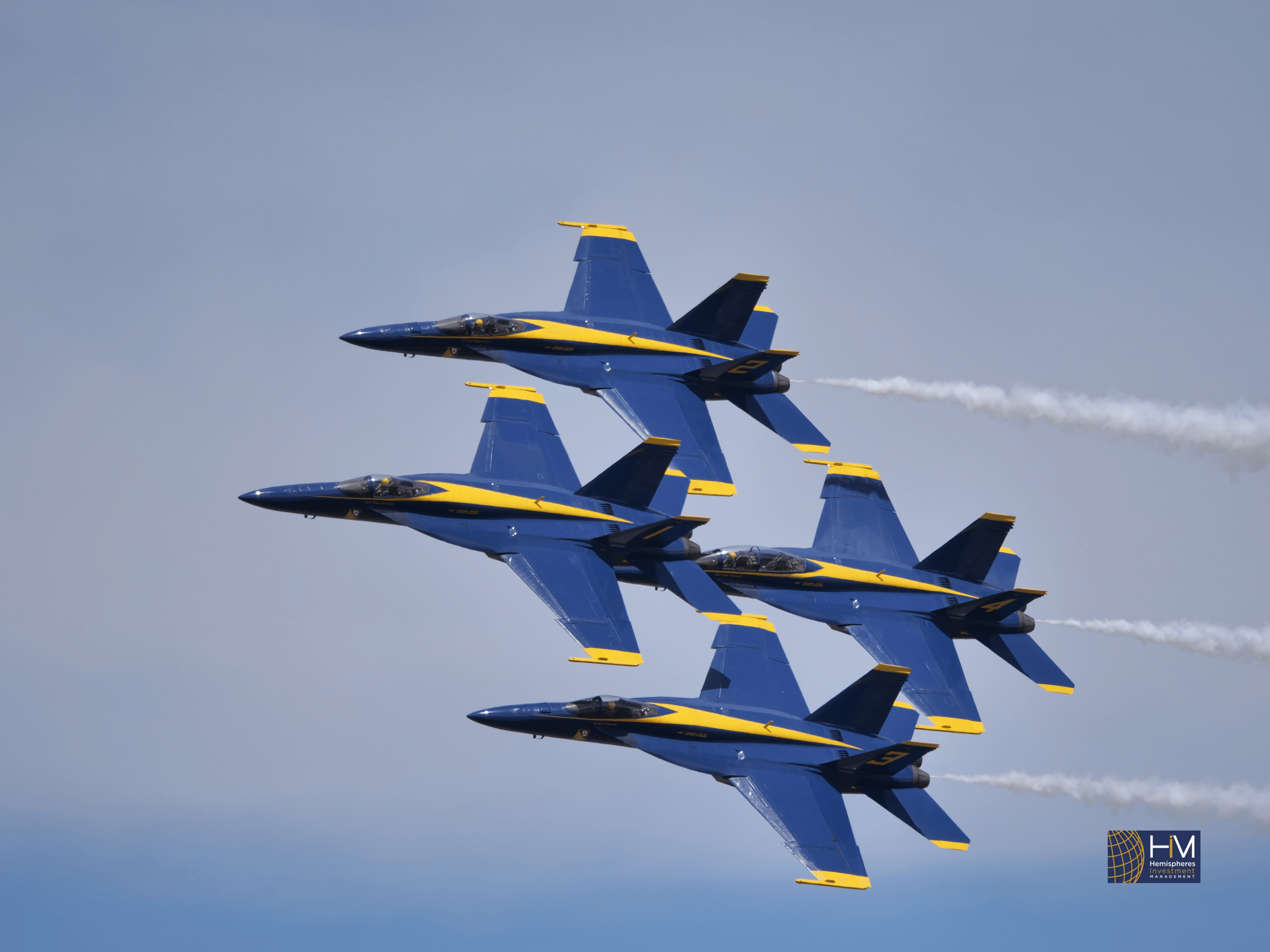The global defense industry encompasses the development, production, and sale of military equipment and services. It plays a critical role in national security, international relations, and global economic dynamics. Global military spending has increased since 2001, driven by various factors such as geopolitical instability, emerging threats, and technological advancements. DOGE’s stated goal is to reduce the military spending budget by 8% annually for the next few years. The ambitious cost containment goal aims to be achieved while replenishing munitions provided to Israel and Ukraine in the ongoing conflicts, as well as advancing the development of new technologies.
Key Players and Market Trends
The defense industry is dominated by a few major players, including Lockheed Martin, Boeing, and Raytheon. These companies engage in research and development, manufacturing, and the provision of a wide range of defense products and services. The industry landscape is characterized by ongoing consolidation, with mergers and acquisitions occurring frequently. This consolidation has resulted in a smaller number of larger, more powerful defense contractors.
Technological Advancements Shaping the Future of Warfare
Technological advances are rapidly transforming the face of warfare. Artificial intelligence (AI) is being integrated into various military systems, from autonomous weapons to intelligence gathering. Robotics is playing an increasingly important role in areas such as surveillance, logistics, and combat operations. Cyber warfare has emerged as a critical domain of conflict, with nations and non-state actors alike engaging in cyberattacks to disrupt critical infrastructure and gain strategic advantage. President Trump recently stated that the United States needs to develop an “Iron Dome” system like the one used by Israel. Presumably, he is referring to Israel’s multi-layered approach to its air defense systems. The United States defense companies, working in collaboration with Israel, have developed David’s Sling and Arrow 3 systems. Israel also has an impressive early warning system.
Iron Dome
Iron Dome Defensive System is a mobile, all-weather air defense system developed by Rafael Advanced Defense Systems and Israel Aerospace Industries. According to Israeli information, Iron Dome is about 90% effective in stopping short-range rockets, [1].
- Key Components:
- Radar System: Detects and tracks incoming rockets and artillery shells.
- Command and Control Center: Analyzes threat data, determines the most effective interception strategy, and commands the launch of interceptor missiles.
- Launcher: Fires Tamir interceptor missiles.
- Tamir Missile: A small, maneuverable missile equipped with a blast fragmentation warhead.
- Operational Capabilities:
- Intercepts: Short-range rockets, artillery shells, and some unmanned aerial vehicles (drones).
- Range: 4 to 70 kilometers (2.5 to 43 miles).
- Altitude: Up to 7 kilometers (4.3 miles).
- All-Weather Capability: Operates effectively in various weather conditions, including rain, fog, and dust storms.
- Rapid Response: Can engage multiple targets simultaneously.
- Effectiveness:
- The Iron Dome has demonstrated a high success rate in intercepting incoming rockets.
- It has significantly reduced the number of rocket impacts in Israeli civilian areas.
- It is not perfect, and some rockets inevitably slip through.
- Significance:
- The Iron Dome has been a game-changer in Israel’s defense strategy.
- It has saved countless lives and significantly reduced the impact of rocket attacks on Israeli civilians.
- It has also served as a model for other countries facing similar threats.
- Limitations:
- Cost: The system is expensive to develop, maintain, and operate.
- Limited Range: Primarily designed to counter short-range threats.
- Not 100% Effective: Some rockets inevitably evade interception.
The Iron Dome represents a significant technological achievement in missile defense. It has proven to be a valuable asset for Israel in protecting its citizens from rocket attacks.
David’s Sling (SkyCeptor)
Israel has a multi-layered missile defense system to protect its citizens from various threats.
David’s Sling is an Israeli air and missile defense system designed to intercept short-range ballistic missiles, large-caliber rockets, and cruise missiles[2]. Here’s a breakdown of its key features.
- Mid-Tier Defense: It fills a crucial gap in Israel’s layered defense system, operating between the shorter-range Iron Dome and the longer-range Arrow systems.
- Joint Development: Developed jointly by Rafael Advanced Defense Systems (Israel) and Raytheon (United States).[3]
- Stunner Interceptor: Employs the “Stunner” interceptor missile, a two-stage missile designed for hit-to-kill engagements.
- Operational Range: Intercepts targets at ranges from 40 to 300 kilometers (25 to 190 miles).
- Altitude: Capable of engaging threats at altitudes of up to 15 kilometers (9.3 miles).
- Multi-Mission Capability: Designed to intercept a variety of threats, including tactical ballistic missiles, medium- to long-range rockets, enemy aircraft, drones, and cruise missiles.
- Key Components:
- Radar System: Uses advanced radar for target detection and tracking.
- Command and Control Center: Analyzes threat data and directs interceptor launches.
- Launcher: Fires the Stunner interceptor missiles.
Significance:
- Enhanced Defense Capabilities: David’s Sling significantly enhances Israel’s ability to defend against a wider range of threats, including those from further distances.
- Improved Regional Security: Contributes to regional security by bolstering Israel’s defense capabilities.
Arrow 3 System
The Arrow 3 is an advanced long-range missile defense system developed jointly by Israel and the United States[4].
- High Altitude Interception: It’s designed to intercept ballistic missiles outside the Earth’s atmosphere (exo-atmospheric interception).
- Key Components:
- Radar System: Employs powerful radars to detect and track incoming ballistic missiles.
- Command and Control Center: Analyzes threat data, determines the most effective interception strategy, and commands the launch of interceptors.
- Launcher: Fires the Arrow 3 interceptor missiles.
- Arrow 3 Interceptor: A two-stage missile with a kinetic warhead, designed to intercept and destroy ballistic missiles in space.
- Operational Range: Intercepts long-range ballistic missiles at very high altitudes.
- Significance:
- Enhanced Defense Against Long-Range Threats: Provides Israel with a critical defense capability against long-range ballistic missiles, particularly those with potential origins from countries like Iran.
- Technological Advancement: Represents a significant technological achievement in missile defense technology.
- Regional Security: Contributes to regional security by bolstering Israel’s defense capabilities against long-range ballistic missile threats.
Arrow 3: This system is designed to intercept long-range ballistic missiles, including those potentially launched from Iran.
Early Warning Systems
These systems, such as “Red Color,” use radar and other sensors to detect incoming rocket launches. 1 When a launch is detected, sirens are activated in affected areas, giving civilians precious seconds to seek shelter. [5]
Geopolitical Factors Driving Defense Spending
Geopolitical tensions and regional conflicts are major drivers of defense spending. The rise of new powers, the resurgence of great power competition, and the proliferation of weapons of mass destruction have created a complex and challenging security environment. Nations are investing heavily in defense to counter these threats and maintain their strategic advantage.
The U.S. involvement in defending Israel and supporting Ukraine has had several effects on US air defense capabilities. Providing significant military aid to both nations has increased demand for defense systems, potentially straining production lines and drawing down US inventories. This necessitates increased production to replenish stockpiles and maintain readiness. The Ukrainian conflict has highlighted the growing importance of counter-unmanned aerial systems (C-UAS) capabilities, spurring research and development in areas like electronic warfare and laser weapons.
The Ukrainian battlefield serves as a testing ground for various air defense systems, providing valuable real-world data for future development and upgrades. Increased demand has strengthened the US defense industrial base but also raises concerns about potential supply chain bottlenecks. The conflict has emphasized the need to focus on near-peer competitors, such as Russia and China, and develop advanced air and missile defense systems to counter their growing military capabilities.
The Ethical Considerations of the Defense Industry
The defense industry raises significant ethical concerns. The arms trade fuels conflicts around the world and can have devastating humanitarian consequences. The development and use of autonomous weapons systems raise complex ethical questions about the role of humans in warfare. The environmental impact of military activities, such as the production of weapons and the use of military bases, also requires careful consideration.
Conclusion
The future of the defense industry presents both challenges and opportunities. Emerging technologies such as hypersonics, directed energy, and space-based systems are transforming the battlefield and creating new avenues for innovation. However, the industry also faces challenges such as budget constraints, evolving threats, and the need to adapt to changing geopolitical realities.
The defense industry will continue to play a critical role in shaping global security dynamics. As technological advancements accelerate and geopolitical tensions persist, the industry will need to adapt and innovate to meet the evolving demands of the 21st century. Based upon the supply drawdown in recent years, coupled with the new political environment in the United States, we anticipate adoption of industry supportive budgets and enhanced technology development goals.
Hemispheres Investment Management
Hemispheres Investment Management is a wealth manager with a global (domestic and international investments in the same portfolio) investment management focus. Our team of seasoned professionals each have over 35-years of experience researching, managing or strategizing investments and investment portfolios, including deep proficiency in U.S., international and emerging markets. Hemispheres can assist you in diversifying your portfolio globally. Global Equities is Hemispheres’ flagship investment product.
Please contact Hemispheres Investment Management for free consultation. We provide guidance and strategies to assist you in optimizing your investment policy and helping you achieve your investment goals. Book a meeting.
This article is for informational purposes only. Consult your financial advisor regarding the suitability of any individual security or sector before investing.
[1] https://www.ajc.org/news/5-things-you-need-to-know-about-israels-iron-dome-defense-system#:~:text=The%20strongest%20air%20defense%20system,control%20system%20that%20determines%20the
[2] https://www.rtx.com/raytheon/what-we-do/integrated-air-and-missile-defense/davidssling#:~:text=The%20David’s%20Sling%20System%20forms,mid%2Dtier%20regional%20missile%20defense.
[3] https://armyrecognition.com/military-products/army/air-defense-systems/air-defense-vehicles/davids-sling
[4] https://www.iai.co.il/p/arrow-3
[5] https://en.wikipedia.org/wiki/Red_Color#:~:text=The%20Red%20Color%20(Hebrew%3A%20%D7%A6%D7%91%D7%A2,the%20Israel%20Defense%20Forces%20in&text=When%20the%20signature%20of%20a,in%20nearby%20Israeli%20communities%20and






